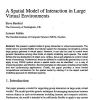Free Online Productivity Tools
i2Speak
i2Symbol
i2OCR
iTex2Img
iWeb2Print
iWeb2Shot
i2Type
iPdf2Split
iPdf2Merge
i2Bopomofo
i2Arabic
i2Style
i2Image
i2PDF
iLatex2Rtf
Sci2ools
ECSCW
1993
1993
A Spatial Model of Interaction in Large Virtual Environments
: We present a spatial model of group interaction in virtual environments. The model aims to provide flexible and natural support for managing conversations among large groups gathered in virtual space. However, it can also be used to control more general interactions among other kinds of objects inhabiting such spaces. The model the key abstractions of object aura, nimbus, focus and adapters to control mutual levels of awareness. Furthermore, these are defined in a sufficiently general way so as to apply to any CSCW system where a spatial metric can be identified - i.e. a way of measuring position and direction. Several examples are discussed, including virtual reality and text conferencing applications. Finally, the paper provides a more formal computational architecture for the spatial model by relating it to the object oriented modelling approach for distributed systems.
| Added | 02 Nov 2010 |
| Updated | 02 Nov 2010 |
| Type | Conference |
| Year | 1993 |
| Where | ECSCW |
| Authors | Steve Benford, Lennart E. Fahlén |
Comments (0)

